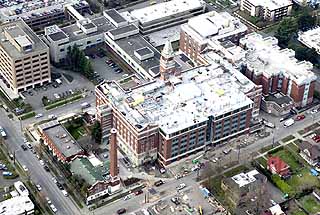
DJC.COM
March 3, 2005
Build it right and they will come
Sabey Corp.

Photo by Dan Crowell/Soundview Aerial Photography
The James Tower Life Science Building on Seattle’s Providence campus is undergoing a $65 million expansion and upgrade to draw medical and biotechnology research tenants.
|
"Building for Biotech" is a great idea if you're certain biotech is coming. But in real estate development as in many other things, the cliche is true: it's best not to put all your eggs in one basket.
Sabey Corp. took this principle to heart when it purchased a portion of the Providence campus in Seattle's Central Area from Swedish Medical Center in 2002. The firm envisioned the site as an opportunity to develop an attractive complex for biotech, research and development, health services delivery and medical device technology tenants that complement each other to fuel their mutual success.
"That may not be consistent with the strictest definition of biotech in some people's minds, but it's a formula that makes a lot sense in practical terms," said Dave Sabey, president and CEO of Sabey Corp.
Providence gets made over
The $37 million purchase from Swedish included the original Providence Hospital, formerly known as the 1910 Building, as well as the Jefferson Tower medical office building, the campus parking garage and other adjacent parcels.
The landmark element of the purchase was the original Providence Hospital. The nearly 100-year-old Beaux Arts-style structure, now called the James Tower Life Science Building, was originally designed by Seattle architects W. Marbury Somervall and Joseph Cote.
On top of the purchase price, $65 million more will be invested in upgrades and new construction. Architects working on James Tower and related Sabey facilities on the Swedish/Providence campus include Callison Architecture, a Seattle firm, and RTKL Associates of Dallas.
In order to attract biotech and related research and medical tenants, the relatively old building needed specific features found in modern laboratory construction, including above-standard seismic and system upgrades. The existing 200,000-square-foot brick and concrete structure also received a 110,000-square-foot addition.
Biotech essentials
"Biotech, life sciences and health services delivery companies each have specific individual facility requirements, yet in general they need the same major features," Sabey said.
"Those include ceiling clear heights of 14 feet or more, floor-loading design that supports a lab's infrastructure and equipment, and dedicated access to mechanical ducting, all of which can be difficult to find in traditional office structures.
"Other essentials include wide column spacing — in James Tower the columns are spaced 32 feet apart to accommodate laboratory benches. These tenants also must have an ample supply of uninterruptible power, with backup generators that kick in automatically as needed, and fiber optic connectivity, which is essential in any research, technology and data driven environment."
A key element in the James Tower redevelopment was the need to retain and restore the historical building's unique front façade as much as possible. Sabey Corp. was able to develop its portion of the campus under the major institutional master plan that had been approved by the city, but still needed approval from the city's Landmarks Preservation Board to make its desired upgrades to James Tower. Neighborhood approval was also important.
"Especially when you are upgrading and expanding a historic building in a neighborhood, it's important to develop something that the community will embrace," Sabey said.
"Our goal was to preserve the exterior of the building in a style that fits the neighborhood and that the community has grown accustomed to, while creating the interior features and ambience necessary to assure biotech and medical companies that this is a campus where they can be productive, creative and successful.
"Our ultimate goal has been to make James Tower Life Sciences Building a powerful magnet for economic growth in the neighborhood and Seattle."
Tenants move in
Even though finishing touches to James Tower won't be applied until this summer, the building is about 70 percent occupied. The largest tenant is Laboratory Corporation of America, a North Carolina company that occupies about 80,000 square feet.
Other tenants include NeuVation, a medical device technology research and development company; Seattle Neuroscience Institute, a research and treatment facility that is part of Swedish Medical Center; and several Swedish offices. Several other technology and health service delivery companies and organizations, including a major educational training college, are in the final stages of becoming tenants at James Tower.
Among Sabey Corp.'s other Northwest biotech/medical developments is Elliott Park North on Seattle's waterfront, which Sabey sold in 2004 but continues to manage. The firm redeveloped Elliott Park North from a 1920s agricultural processing plant into a class A biotech facility.
Elliott Park is home to Chiron Corp., which develops pharmaceuticals, vaccines and blood-testing products; Cell Therapeutics Inc., which develops drugs for fighting cancer; and Amgen Corp. (formerly Immunex), a biopharmaceutical company that develops immune system science innovations.
Marcelo Garces is the associate vice president for leasing and development for Sabey Corp., a $400 million real estate development, construction services and investment company based in Seattle.
Other Stories:
- Building a foundation for biotech
- Can Seattle become a first-tier biotech hub?
- Laptops, Treos and phones! (Oh my!)
- Form follows function, even for biotech
- New buildings bring science into the city
- How one local developer took the biotech plunge
- 6 myths about building for biotech
Copyright ©2009 Seattle Daily Journal and DJC.COM.
Comments? Questions? Contact us.